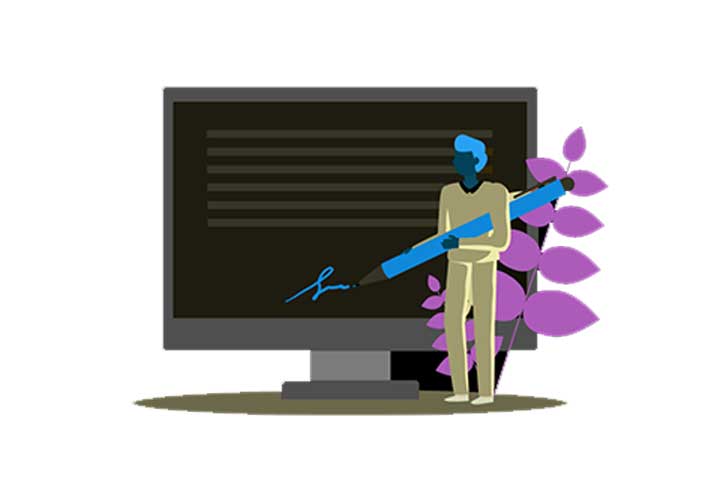Document Signing: Digitally Sign Documents
In today’s fast-paced world, businesses and individuals alike are constantly on the lookout for ways to simplify their workflows and save time. One way to accomplish this is through the use of digital document signing. Digital signatures are a secure and legally recognized way to sign and authenticate electronic documents, offering a wide range of benefits over traditional paper-based methods.
Table of Contents
Digital signature solution for businesses
In today’s fast-paced digital world, the ability to sign documents electronically has become a vital tool for businesses and individuals alike. Digitally signing documents streamlines processes, enhances security, and ensures the authenticity of signed materials. Whether you are closing a business deal, signing a lease, or approving a contract, digital signatures offer a convenient and legally recognized method to validate documents without the need for physical presence or paper.
How to use digital signatures:
- The integrity of the document
- The authenticity of the document
- Non-repudiation
- The timing of signing
Documents such as invoices, contracts or powers of attorney, financial records, and plans, which may contain trade secrets, usually also collect sensitive information. Such documents must be signed so that they remain secure and their integrity and trustworthiness are maintained. This is precisely what Document Signing Certificates do: In today’s article, we will explain what the digital signature is, which regulation clarifies the legal, and how the digital signature works.
What is Digital Document Signing?
Digital document signing is the process of electronically signing and authenticating a document using a digital signature. Unlike traditional paper-based signatures, digital signatures are based on cryptographic techniques that ensure the integrity, authenticity, and non-repudiation of a document.
Digital signatures work by using a pair of cryptographic keys: a private key and a public key. The private key is kept by the signer and is used to create the digital signature. The public key, on the other hand, is made available to anyone who wants to verify the signature. When a document is signed with a digital signature, the signature is generated using the signer’s private key and can only be verified using their public key.
Best electronic signature apps to sign documents online
Digital signatures have revolutionized the way we handle documents, offering a secure, efficient, and legally recognized method of signing. By understanding how they work and their benefits, you can streamline your workflow and ensure the integrity and authenticity of your signed documents. Embracing digital signatures is a step towards a more modern, paperless, and secure way of doing business.
The best eSignature software’s
- Docusign: businesses that sign lots of things
- Preview: occasionally signing documents on a Mac
- Adobe Acrobat Reader: occasionally signing documents on a PC
- eSignatures.io: a pay-as-you-go option
- SignWell: a free document signing app
- SignNow: small teams
What are digital signatures and certificates?
The terms “digital signature” and “electronic signature” are often used synonymously. However, it is not the same: The term “electronic signature” is understood to be the digitized counterpart to the handwritten signature. This form of signature is used wherever content in documents or regulations needs to be confirmed.
Also Read: Ultimate Linux Distro Guide
The electronic and digital signature thus differ in one significant point: The digital signature guarantees integrity and authenticity to the extent that it can withstand legal proceedings. Due to the cryptographic process, the digital signature verifies and secures:
- The authenticity and the verified source of the document.
- The freedom of manipulation of the record since the digital signature was created. If documents are changed after the signature has been affixed, the signature is displayed as invalid.
- The verification of the identity of the signatory by a trustworthy organization (CA).
On the other hand, the digital signature is the equivalent of a notarized signature: a responsible third party, namely the certification body instead of the notary, confirms the identity of the signatory. The verified identity is bound by the certificate authority (CA) to a PKI-based digital certificate (“Document Signing Certificate”). This makes it easy for signers to use digital signatures in electronic documents and cloud-based signing platforms. A digital signature uses a cryptographic algorithm to create a unique digital fingerprint to combine the digital certificate with the digitally signed data.
Top free Services create Digital signature
The different document services or platforms offer different types of signatures. With Microsoft Word as well as Adobe PDF, we’re looking at two of the most popular:
How to Digitally Sign a Word Document
- Microsoft supports visible and invisible digital signatures in its office suite. Similar to a physical document, a signature line appears with the digital visual signature.
- If several users – for example, two contractual partners – have to sign agreements, this method is usually used.
- You will see a blue band in the Word system tray when you open a document with an invisible signature.
- The invisible signatures are used when the document’s authenticity, integrity, and origin have to be guaranteed without a conventional signature line in the paper.
- Microsoft provides further information on the signature in Office documents on its in-house support website.
Sign digitally with Adobe PDF
- In addition to the certified signature, Adobe also supports the approved signature. Suppose you add a certification signature to a PDF.
- In that case, this signature not only makes it clear that you are the author of the document and that you have completed the content, but the signature also prevents the document from being tampered with after it has been distributed.
- If a PDF document is signed in a certified manner, a blue ribbon is visible at the top of the document, which shows the signer’s name and the issuer of the certificate.
- The security for the authenticity and the authorship of the record is visible.
- Approved signatures are intended to accelerate the approval process in companies: The electronic approvals issued by departments or responsible persons are recorded and embedded in the original PDF document.
- Approval signatures can be individualized to add images such as the handwritten signature or signature details such as place, date, or reason.
What is digital signature and how it works?
Signing a document digitally is quick and easy, and can be done in just a few simple steps:
Create a digital signature: To create a digital signature, you’ll need to generate a pair of cryptographic keys. You can do this using a digital signature software or service, such as [company name].
Sign the document: Once you have a digital signature, you can use it to sign any electronic document. Simply open the document in your preferred software or service, and add your digital signature.
Verify the signature: To verify the signature, the recipient can use any digital signature software or service that supports the same cryptographic standards as your digital signature.
Benefits of Digital Document Signing
There are many benefits to using digital document signing over traditional paper-based methods. Some of the most notable advantages include:
- Convenience: With digital document signing, you can sign and authenticate documents from anywhere, at any time, using any device. This eliminates the need for physical meetings, printing, scanning, and mailing, saving time and money.
- Security: Digital signatures are based on advanced cryptographic techniques that ensure the integrity, authenticity, and non-repudiation of a document. This makes them far more secure than traditional paper-based signatures, which can be easily forged or tampered with.
- Compliance: Digital signatures are legally recognized in many countries around the world and meet the strictest regulatory requirements, such as the eIDAS Regulation in Europe and the ESIGN Act in the United States.
- Sustainability: By eliminating the need for physical meetings, printing, scanning, and mailing, digital document signing is far more environmentally friendly than traditional paper-based methods.
How to sign documents online: Digital signature vs. electronic signature
You need an appropriate certificate for legally compliant digital signing: You can obtain so-called document signing certificates from various providers. As the signature creator, you apply for the certificate from your trusted provider and identify yourself. Once this ordering process has been completed, you will soon digitally sign the first documents.
Also Read: 6 Ways To Use Technology To Manage Your Home
To do this, a hash value is first generated from the message to be signed by you – a special deal that cannot be reversed. The signer encrypts this hash value with his private key and adds the character string, i.e., the signature, to the message. Whoever receives the message can decrypt the signature using the signer’s public key.
How to select best electronic signature app?
How digital signature works: task now is to compare the hash value obtained with the hash value calculated from the news. If the values match, the signature is correct: The recipient can now be sure that the identity of the person signing and the integrity of the message or document are guaranteed. On the other hand, if the paper was changed after it was signed or incorrectly signed, the comparison of the hash values yields errors.
eSignature app has to meet a few criteria:
- The ability to add an electronic (or digital) signature to any document.
- The ability to send a document to someone else to have them sign it.
- Accessibility for small to mid-sized businesses.
- Security.
- A free trial (or free plan).
FAQs on Digital Signature
- What is a digital signature? A digital signature is an electronic form of a signature that can be used to authenticate the identity of the signer and ensure that the content of the document has not been altered after signing. It uses cryptographic techniques to provide security and verification.
- How do digital signatures work? Digital signatures work by using a pair of keys: a private key and a public key. The signer uses their private key to create a unique digital signature for the document. This signature can be verified by anyone with access to the signer’s public key, ensuring the document’s integrity and the signer’s identity.
- Are digital signatures legally binding? Yes, digital signatures are legally binding in many countries, including the United States and the European Union. Laws such as the ESIGN Act in the U.S. and the eIDAS Regulation in the EU recognize digital signatures as valid and enforceable, provided they meet certain criteria.
- What are the benefits of using digital signatures? Digital signatures offer several benefits, including enhanced security, reduced paperwork, faster transaction times, and cost savings. They also reduce the risk of forgery and tampering, as digital signatures are unique to the signer and any alterations to the document after signing are detectable.
- How can I start using digital signatures? To start using digital signatures, you will need to choose a digital signature service provider or software that meets your needs. These services often provide tools for creating, sending, and managing digitally signed documents. Examples of popular providers include Adobe Sign, DocuSign, and HelloSign. You will also need a digital certificate issued by a trusted Certificate Authority (CA) to ensure the authenticity of your signatures.
Conclusion
we understand the importance of a streamlined and efficient document signing process. Our digital signature solutions offer unparalleled convenience, security, and compliance, making them the ideal choice for businesses and individuals alike.
In conclusion, digital document signing offers a wide range of benefits over traditional paper-based methods, including convenience, security, compliance, and sustainability. By using a digital signature software or service, such as [company name], you can simplify your workflows, save time and money, and ensure the authenticity and integrity of your documents. Try our digital signature solutions today and experience the future of document signing.




